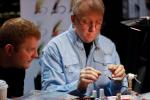
FIN-ITE 34
-
Content Count
614 -
Joined
-
Last visited
Posts posted by FIN-ITE 34
-
-
One observation is you have a ton of fuzz on your wrappings. If you are using rod wrapping thread then you have a problem that needs to be sorted out because that fuzz will make for all kinds of hell when coated.
-
For those that need an education:
A buff or Buff

A balaclava

A buff or Buff is a tube. A balaclava is a hat, face mask and neck gaiter all rolled into one.
-
It will all change after you take your first deer.
-
"They're there"
-
I too have been using the loop to oversized loop for quick change. I mostly use tube flies for my pike fishing and after the wire trace/hook is placed thru the tube, I pass the whole setup thru the large perfection loop in the end of my fluorocarbon leader.
Makes changing flies quick and easy. I found the setup on the Niklaus Bauer website.
-
I think it would make a good sulphur emerger.
For refloating, I would use Frog's Fanny or Doc's Dry Dust as I have no trouble reusing a CDC after application.
-
A midge and a scud pattern.
-
Welcome j8000, if you are not yet addicted, then keeping hanging out here and you will be #can't stop.won't stop
Never thought I'd see a Miley Cyrus reference on this site.
Well done.
I'm a little scared that you knew it was a Miley reference.
-
I like the Montana Fly Company Speckled Sexi Floss. Same material as others have listed, except that it is already barred.
-
I doubt Davie has a clue about Deflategate.
Mac, check out flytire's avatar.
-
-
Flytier, are you Mr. McPhail? Or are you just reposting something you like from him?
Almost spit out my coffee when I read this. Not at your question Mac, but at the thought.
-
Any super tacky wax will work and the key is to card the dubbing to align the fibers so that they will be "touched" placed perpendicular to the thread.
Look through the videos of Matt Grobert on his Caddis Chronicles blog. Here is one video where he talks about split thread vs. touch and shows in a video how to touch dub.
Matt is a big proponent of touch dubbing.
http://www.caddischronicles.com/2013/11/split-thread-vstouch-dubbing.html
-
The deer underfur mixed with chopped deer hair makes a great caddis dry fly dubbing.
-
Definitely after every fish. After that it will be up to you to determine when by observing if the fly floats as it should. If a false cast or two does not dry the fly to float properly then it is time to re-apply.
If I am not constantly drowning my fly in heavy water, I can get many drifts out of a freshly dusted fly.
-
Absolutely, after catching a fish you will have to rinse off the fly (de-slime), dry off (I just smush it against my cotton t-shirt) and re-apply a coating of "dust" It only takes a minute to complete the process needed to attend to CDC. When you are dry fly fishing slowing things down can be an advantage.
You will also have to re-apply the dust after a period of time as the fly begins to absorb too much water. Again, not a big deal, just press against your shirt and re-apply the dust.
The dust is great stuff for drying out a fly, even a hackled version.
The CDC fly is unique in that hackle is not necessary to float the fly. However you can also use hackle with the CDC, but there will be times that the CDC alone is what the fish will eat over a hackled fly.
In that case it "is worth the effort".
-
Try some Frogs Fanny or Doc's Dry Dust with the CDC.
Oh, and don't be stingy with the CDC on your patterns.
-
Looks just like the one I made, except later on I made some fancy, height adjustable stanchions with roller bearings and rubber o-ring tires.
If you are going to glue your felt to the uprights, make sure you don't poly that surface as you will get better adhesion to the bare wood.
-
What hook did you use?
What emerger pattern did you tie?
-
Both I and any person that is or has trapped, know that a fleshing knife, either single or double handled fleshing knife is not used for skinning or field dressing. A fleshing tool is used to scrape the remaining fat and flesh from a hide after it is skinned and before stretching.
-
Brown Trout © Joseph R. Tomelleri
The brown trout was first brought into this state in the 1890s and is now abundant from high mountain streams to broad rivers flowing onto the plains. These fish can be difficult to catch, but many anglers have good success during their fall spawning runs. A large dark spotting pattern and reddish dots can help anglers distinguish these fish from rainbows and cutthroats.e.co.us/learn/pages/fishid.aspx
-
-
-
DrV- Brown trout were never "native" to North America. They were introduced in the later part of the 19th century from the UK and Germany.



Rod wrapper help
in The Lodge
Posted · Report reply
Steve, what are you using for a burnisher these days? I still use a Letraset burnisher for tightening up and smoothing down my wraps. I would imagine that the burnisher I use is no longer available with the extinction of transfer lettering.